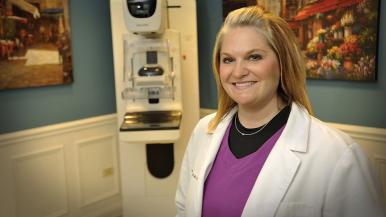While an annual mammogram is still the gold standard for detecting breast cancer, that may not be enough for women with a high risk of breast cancer. Rush Copley’s high-risk breast clinic provides a personalized approach to breast health that includes comprehensive breast cancer screening, cancer risk assessment and genetic risk evaluation as well as genetic counseling and testing — which can help detect breast cancer in patients earlier.
Risk assessment
Cancer risk assessment is part of every annual mammogram at Rush Copley where an advanced risk assessment tool is used to determine the patient’s lifetime and mutation risks for breast and ovarian cancer. The technologist asks the patient a series of questions regarding personal and family history. The assessment tool then uses this information, along with breast density, to run risk models, resulting in risk calculations that give a complete picture of the patient’s cancer risk as well as personalized recommendations.
“Based on the results of the cancer risk assessment, we might recommend additional imaging, genetic testing or both,” says Jennifer Yanak, MSN, MBA, FNP-BC, the nurse practitioner who manages the high-risk breast clinic.
Yanak works closely with patients who have been identified as having an elevated risk due to either density, family history or a variety of other factors. “We empower patients through education,” she says. “They have a role in choosing to do the additional testing.”
Additional screening
Rush Copley offers the latest, most advanced breast imaging technology. A 3D mammogram, known as tomosynthesis, is the norm for all Rush Copley patients. For those identified as having a higher risk of cancer, additional screening could help to detect breast cancer sooner. An automated breast ultrasound, or ABUS, may be recommended for patients with heterogeneous or extremely dense breast tissue; this can often be performed on the same day as the mammogram. For patients identified as having a high lifetime risk (>20%), a screening breast MRI exam can be performed in just under 12 minutes. This exam is typically scheduled at six-month intervals from the annual mammogram so that the high-risk patient is monitored twice a year.
Genetic testing
If a patient is identified as having an increased mutation risk, she may be a candidate for genetic testing and can schedule a free consultation with Yanak. This 20-minute appointment includes genetic counseling, a review of risk reduction strategies and genetic testing — if warranted — via a saliva sample. The cost of genetic testing and analysis is usually covered by insurance. However, if a patient will incur a cost, they will be notified prior to the processing of the sample and given the option of canceling. Results of the testing are typically available in one to two weeks.
Personalized medicine
“The high-risk breast clinic provides the most personalized, advanced breast care for patients”, says Gloria Hall, director of the Midwest Center for Advanced Imaging. “Patients get so much more than a mammogram. We help them understand their complete risk level and how to mitigate that risk with clinically proven strategies.
“Technology is constantly changing,” she says. “As a system, Rush is at the forefront of the most advanced imaging and services to help patients decide what is the most cost-effective, least invasive, and best use of their time and dollars to give them the best outcome.”
Request an appointment here.




